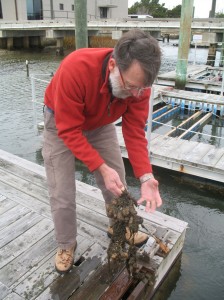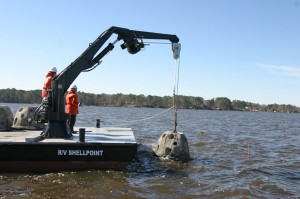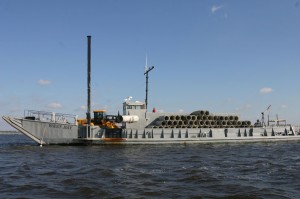By JERRY ALLEGOOD
Building artificial fishing reefs in North Carolina’s coastal waters used to be a matter of sinking old ships offshore or dumping overboard an array of junk — abandoned airplanes, railroad cars, concrete chunks and thousands of automobile tires.
Fish and other creatures did the rest, it was assumed — with some taking up residence in, on and around the clutter; others stopping by to cruise, hide out or dine.
It’s not that simple now.
Facing tight budgets and environmental concerns, North Carolina is more selective about what and where things go in the water. In the last two years the state has focused on creating new fishery habitat in estuarine areas where fresh water from rivers and streams mixes with seawater.

Dan Rittschof on the docks at Duke University’s Marine Laboratory in Beaufort displays the types of growth that spring up on offshore reefs. Photo by Jerry Allegood.
With financial assistance from fishermen and private groups, the state is beefing up unproductive river bottoms with hundreds of custom-made “reef balls” that serve as concrete condos for fish. In addition, the state dumps tons of plain old concrete pipe and limestone marl overboard to make more ramshackle underwater homes and habitat. The upshot is more nursery area for younger fish and more accessible reefs for anglers who gather to catch bigger fish.
Jim Francesconi, the North Carolina Division of Marine Fisheries’ artificial reef program director, says finding suitable reef sites in estuarine areas is more difficult, but worth the effort. “We were forced into doing something good,” he says.
The state’s artificial reef program includes 40 ocean reefs and eight in estuarine waters. The state also built 10 oyster reefs with discarded oyster shells and marl — small chunks of rock — to enhance shellfish resources. State regulations permit hook-and-line fishing on the oyster reefs, but not trawls, long haul or swipe nets.
Building reefs in the ocean to accommodate fishing — the state’s primary approach since the 1970s — is mainly a harvest approach for mature fish, Francesconi says. “By enhancing the estuarine reefs, however, we are able to front-load the equation by creating habitat” for younger fish.
GOING INSIDE
Reefs in so-called “inside,” or estuarine, waters benefit popular species, including black sea bass, gag grouper and flounder.
These fish spawn offshore, but their tiny larvae enter inside waters where they feed and grow before returning to the sea.
“Their nature is to be around structures,” Francesconi says. “They cruise structures.”
Although the smaller juvenile fish are off-limits to fishermen, they eventually help rebuild offshore fish populations that are under strict management.
The first documented artificial reefs in the United States were 4-by-4-foot log huts placed in South Carolina waters in the 1830s to enhance fishing for sheepshead, according to the 2004 Guidelines for Marine Artificial Reef Materials by the Atlantic and Gulf States Marine Fisheries Commissions. Shipwrecks have formed reefs for centuries, but the earliest account in the United States of intentionally sinking vessels for reefs was in 1935. Coastal states have achieved varying success with subway cars, planes, trains and automobiles — even military tanks that ended service beneath the sea.
North Carolina’s underwater inventory reads like a junkyard journal. Scores of vessels — tugboats, barges and fishing boats — also have been stripped, cleaned and intentionally sunk in the Graveyard of the Atlantic off the coast. One site off Atlantic Beach includes a 440-foot-long World War II Liberty Ship, a steel-hulled sport fishing boat, three F-4 jets and a CH-46 helicopter.
Tons of concrete rubble, bridge pilings and boatbuilding molds were dumped overboard along with thousands of concrete pipes.
These “structures” attract fish soon after settling in place. Over time, marine organisms latch on. Small fish come to feed, attracting larger fish sought by anglers. Francesconi says discarded concrete pieces, such as wet wells or manhole sections, are covered with sponges, making their original shape indistinguishable.
MESH BAGS COULD HELP

The Shellpoint’s crew carefully deposit a reef ball into the Neuse River near Oriental. Photo by Jim Francesconi.
A four-year study by Dan Rittschof, an ecology professor and researcher at Duke University’s Marine Laboratory in Beaufort, suggests that the number of fish on artificial reefs could be increased by placing mesh bags in the reef balls and concrete pipes. The bags, made of Vexar plastic, provide small creatures some refuge from grazing and predatory fish.
During the study, supported by the North Carolina Fishery Resource Grant Program, researchers established paired control and experimental sites at five reefs near Beaufort.
Bags were inserted into the reef and divers and fishermen counted fish. Both kinds of monitoring indicated increased numbers of fish at the augmented reefs, researchers report.
However, Rittschof cautions that the study was preliminary and it does not address long-term effects of using plastic in the ocean. The bags could lose their effectiveness over time as they become clogged up. In addition, he says, there is a concern that even minute amounts of chemicals in the plastic might harm marine creatures.
Francesconi said it was unlikely the state could take on additional costs of placing bags in reef materials. “It’s not on the radar at all,” he says. “The real benefit (of the study) is to help us understand the ecology of the reefs.”
NO MORE TIRES
North Carolina, like several other states, tried to make new fishing grounds by creating dumping grounds for old tires. It seemed like a great idea at the time, because tires break down slowly and an estimated 2 billion were stockpiled around the country at the time. But those road-worn tires outlasted the chains and cables anchoring them to the bottom and started washing up on beaches.
About 650,000 tires were placed in North Carolina reefs between 1975 and 1983, according to the marine materials guidelines. Since 1989, about 100,000 tires were removed from North Carolina beaches at a cost of more than $1 million. Hurricane Bonnie rolled up 28,000 in 1998 and as recently as September 2010, tires dotted Atlantic Beach beaches after Hurricane Earl.
As part of the current reef focus, the state has enhanced two older reefs, one near New Bern and another at Oriental. Two others are in progress, at Bayview on the Pamlico River and on the New River near Jacksonville. Other estuarine reefs are near Edenton, at Quilley Point on the Pungo River, near Buxton on Hatteras Island and at Ocracoke. “It’s refreshing to see (reef work) come in-shore,” says Stephen Ammons, executive director of the Coastal Conservation Association of North Carolina.
The organization of recreational saltwater fishermen donated $20,000 worth of marl that was dumped in an older reef in the Neuse River near New Bern in January. Rock raises the bottom profile and provides hard surface for vegetation and small creatures. They attract crabs, small fish and other species, which in turn attract larger fish, including striped bass.
The state Division of Marine Fisheries distributed 506 tons of marl at 1111 mounds in 11 acres of a reef site developed in the 1970s with old automobile tires. In February, DMF sent two vessels back to the New Bern site to carefully place 99 dome-shaped concrete balls in another area of the reef. Each reef ball contains large porthole-like openings to allow free flow of water and fish. Weighing in at 2,300 pounds each, the reef balls aren’t likely to move around in currents or storms.
Biologists also measure the sediment bottom to make sure that flat-bottomed domes don’t sink out of sight. “Some of it is very soft, like fluffy mud,” explains Chris Jensen, a DMF biologist. “Thus, care is taken to make sure the reef balls are not quickly buried in mud.” On the other hand, DMF measures the water depth to make sure there is at least five feet of clearance overhead so boats can pass over.
UNDERWATER REAL ESTATE
Custom-made reef balls, which cost about $180 to $214 each, are considered the top-of-the-line real estate in reefs. A few reef balls in North Carolina waters even contain the remains of ardent fishermen who were cremated and had their ashes mixed in with the concrete.
Although DMF buys reef balls, it puts out far more concrete pipe because it’s cheaper and durable. Francesconi says he can buy a truckload of concrete pipe weighing 24 tons for about $500. The pipes are often cracked or irregular discards that would have gone
to a landside disposal site. In the water, they are expected to last more than 300 years and remain where they settle. “Pipe has not moved off-site anywhere,” Francesconi says.

Concrete Pipes, soon to become reefs, line the deck of the West Bay. Photo by Jerry Allegood.
The state plans to put out 401 additional reef balls at the Neuse River reef, about 2.6 miles from Union Point in New Bern — in an area with plenty of boating activity and scenic shoreline.
Farther downriver at Oriental, fishermen and community residents raised more than $17,000 for improvements to an older reef that was decimated in recent years by storms. The donations paid for 32 reef balls and tons of marl. The state added 18 more reef balls, additional marl and 1,000 tons of concrete pipe in portions of a 63-acre tract.
During a bright, sunny day recently, Ron Zielinksi maneuvers his boat around the state research vessel West Bay so he and Wyatt Cutler, former Oriental town manager, can get a look at the progress on the reef. On board the West Bay, a heavy-equipment operator uses his machine’s crane to lift huge concrete pipes two at a time and drop them into the river with a huge splash.
Zielinski, an avid fisherman and part-time charter boat operator, is pleased to see the debris plummet into popular fishing grounds near his home.
“I thought we were getting gold pipe,” he shouts to state workers on another boat monitoring the work. “That’s on the inside,” someone calls back.
Zielinski says the reef just off the town’s scenic waterfront will be a good way to bring back fishing to a prime area. “We’ve got so many fish — speckled trout, croakers,” he says. “Spanish mackerel come in every year and they love it.”
Zielinski and a friend, Steve Speciale, started a local campaign about three years ago that raised money for the reefs with donations and raffles, and even by making and selling rain barrels. Cutler said the town of about 875 people supported the project as a way to boost the economy by attracting fishermen and tourists.
Francesconi and colleagues are gathering information for improvements at an older reef at Bayview, near the mouth of Bath Creek in the Pamlico River. The 17-acre reef, a half mile from shore, contains about 28,000 tires still functioning as reef material.
DFM officials note the project is complicated because the proposed area contains soft bottom that makes construction more challenging. In addition to new material types, they are considering an expansion into shallower water with firmer bottom.
Work is under way on the state’s newest estuarine reef, a 31-acre site in the New River near Jacksonville. The project developed by the DMF and the Riverworks at Sturgeon City in Jacksonville received a two-year, $563,000 grant funded by state Coastal Recreational Fishing License revenues.
That reef, four miles south of downtown Jacksonville, helps to recycle concrete debris left from demolition of the Herbert G. “Buddy” Phillips Bridge.
Concrete in pieces ranging from about the size of baseballs to basketballs will form a series of mounds throughout the reef’s 22 acres. Fishermen will be able to drop their lines in lanes between the mounds, or fish from the mound tops.
J.P. McCann, executive director of the Riverworks program, says the concrete mounds create hard surface on what had been soft, unproductive river bottom. He compares the reef to a desert oasis, saying a “halo of life” will radiate out from the man-made mounds.
The DMF’s Francesconi says the estarine reefs will benefit those who can’t afford a large boat to go offshore or can’t withstand the rigors of ocean fishing. He notes that the reef near Union Point at New Bern is only a few minutes from a public boat launch.
“That’s sweet,” he says. “I’m looking forward to taking my canoe to that place.”
This article was published in the Spring 2011 issue of Coastwatch.
For contact information and reprint requests, visit ncseagrant.ncsu.edu/coastwatch/contact/.
